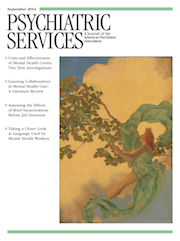The nation’s key agency on caring for people with mental illness, the Substance Abuse and Mental Health Services Administration (SAMHSA), has lately been in the crosshairs of the U.S. Congress. In late 2013, Representative Tim Murphy (R-PA) proposed the Helping Families in Mental Health Crisis Act to address a long list of inadequacies in services for people with schizophrenia, bipolar illness, major depression, and other severe conditions. It has received robust bipartisan support.
The Murphy bill is wide ranging, attending to the shortage of beds for patients with mental disorders, lax commitment statutes, overly narrow privacy provisions of the Health Insurance Portability and Accountability Act, and poor collaboration between the mental health and criminal justice systems, among other problems. However, it trains a spotlight on SAMHSA. This is because Mr. Murphy, along with other advocates for people with severe mental illness, deems the agency derelict in attending to the sickest individuals.
One striking manifestation of SAMHSA’s vision is its enthusiasm for models of care that many people with chronic psychosis are not capable of using. Years ago, SAMHSA embraced the “recovery model” as its guiding philosophy of care (
1). As the agency states, the model is aimed at “consumers” who, according to President Bush’s New Freedom Commission, can “participate fully in their communities” (
2).
But what about individuals, otherwise known as “patients,” who because of their illness may at times need to be taken care of by others? Although SAMHSA receives much of its input from “consumers,” they do not speak for the agency’s most impaired constituents, who are languishing in jails, emergency rooms, or on the streets or who are too lost in psychosis to show up for a focus group. They are too sick to take advantage of treatment or to “fully participate” in creating a life plan. As we know, at least half of all untreated people with a psychotic illness do not acknowledge that there is anything wrong with them (
3), a condition technically called anosognosia. These are the most vulnerable of SAMHSA’s constituency. Yet not nearly enough interest and resources are invested in their well-being.
Consider SAMHSA’s National Registry of Evidence-Based Programs and Practices (
www.nrepp.samhsa.gov). Known as NREPP, it is an online registry of mental health interventions that are certified by SAMHSA as evidence based. State mental health departments are encouraged to expend their block grant money—a funding program overseen by SAMHSA—on these interventions. On the NREPP site, SAMHSA lists 333 separate evidence-based programs. Many are sound efforts to treat substance abusers and drug offenders. Others are broad-focus prevention programs that may be useful if well executed—but, crucially, like the vast majority of programs listed on NREPP, these are not intended for the sickest individuals.
The striking nature of the NREPP repertoire is its imbalance. Only a handful of programs are specifically designated for people with severe illness: Compeer, critical time intervention, Housing First, and the psychiatric rehabilitation process model. Only critical time intervention, which provides time-limited case management under supervision of a psychiatrist or psychologist, is narrowly aimed at people with serious, debilitating conditions. A smattering of other programs—the modified therapeutic community, International Center for Club House Development, and Wellness Recovery Action Planning (WRAP)—do not specifically mention severe mental illness in their descriptions, but they presumably serve those patients. However, WRAP is only eight weeks long and is “designed to create a safe, nonjudgmental autonomy-supportive environment in which people feel motivated to manage their mental health issues” (
4).
Even if I missed some programs in my review of the NREPP program synopses, it is abundantly clear that services aimed specifically at the most desperately ill—those in the most intense phase of their psychotic illness—represent only a small minority of the NREPP programs. Outcome measures should examine the effects of interventions on homelessness, incarceration, hospitalization, violence, and suicide. This is not reliably the case with the NREPP programs.
Furthermore—and remarkably—NREPP does not include one of the most effective and best-studied programs for individuals with severe mental illness: assisted outpatient treatment (AOT). AOT is a cost-saving and effective form of civil court–ordered community treatment for individuals who have a reliable pattern of falling into a spiral of self-neglect, self-harm, or dangerousness when they do not take medication. AOT is well documented to reduce hospitalizations, homelessness, arrest, victimization of people with mental illness, and violent behavior (
5–
7).
A rival bill to Mr. Murphy’s, introduced in May 2014 by Representative Ron Barber (D-AZ), contains no strong provisions aimed at helping individuals with the most severe mental illnesses. If it derails the Helping Families in Mental Health Crisis Act or a suitable compromise bill, the most helpless patients will pay the price.
To the detriment of the sickest patients, SAMHSA has long extolled the recovery model. Granted, the agency’s biases are not the sole cause of our troubled and fractured mental health system. But the agency’s control of the block grant process ensures that its ideology trickles down to the states. The welfare of patients who are desperately ill depends on the nation’s top agency on mental health to promote and enact a more balanced and pragmatic agenda.
Acknowledgments and disclosures
The author reports no competing interests.

